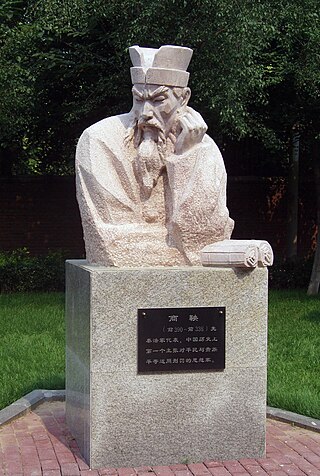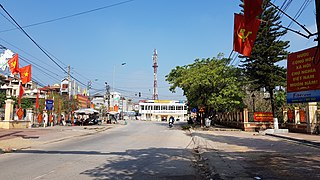The Tao or Dao is the natural way of the universe, primarily as conceived in East Asian philosophy and religion. This seeing of life cannot be grasped as a concept. Rather, it is seen through actual living experience of one's everyday being. The concept is represented by the Chinese character 道, which has meanings including 'way', 'path', 'road', and sometimes 'doctrine' or 'principle'.

Dao are single-edged Chinese swords, primarily used for slashing and chopping. They can be straight or curved. The most common form is also known as the Chinese sabre, although those with wider blades are sometimes referred to as Chinese broadswords. In China, the dao is considered one of the four traditional weapons, along with the gun, qiang (spear), and the jian, called in this group "The General of Weapons".

Fajia, or the School of fa (laws,methods), often translated as Legalism, is a school of mainly Warring States period classical Chinese philosophy, whose ideas contributed greatly to the formation of the bureaucratic Chinese empire, and Daoism as prominent in the early Han. The later Han takes Guan Zhong as a forefather of the Fajia. Its more Legalistic figures include ministers Li Kui and Shang Yang, and more Daoistic figures Shen Buhai and philosopher Shen Dao, with the late Han Fei drawing on both. It is often characterized in the west along realist lines. With Shang Yang, Shen Buhai and Han Fei taken as a source for Qin dynasty practices by the Han, the Qin to Tang were more characterized by its tradition.

A circuit was a historical political division of China and is a historical and modern administrative unit in Japan. The primary level of administrative division of Korea under the Joseon and in modern North and South Korea employs the same Chinese character as the Chinese and Japanese divisions but, because of its relatively greater importance, is usually translated as province instead.
King Dao of Zhou, personal name Ji Meng, was a king of the Chinese Zhou dynasty.

The zhanmadao was a single-bladed anti-cavalry Chinese sword. It originated during the Han dynasty and was especially common in Song China (960–1279).

A guandao is a type of Chinese polearm that is used in some forms of Chinese martial arts. In Chinese, it is properly called a yanyuedao, the name under which it always appears in texts from the Song to Qing dynasties such as the Wujing Zongyao and Huangchao Liqi Tushi. It is comparable to the Japanese naginata and the European fauchard or glaive and consists of a heavy blade with a spike at the back and sometimes also a notch at the spike's upper base that can catch an opponent's weapon. In addition, there are often irregular serrations that lead the back edge of the blade to the spike. The blade is mounted atop a 1.5 to 1.8 m long wooden or metal pole and a pointed metal counterweight used to balance the heavy blade and for striking on the opposite end.

The miaodao (苗刀) is a Chinese two-handed dao or saber, with a narrow blade, long hilt, and an overall length of 1.2 m or longer. The name means "sprout saber", presumably referring to a likeness between the weapon and a newly sprouted plant. An early reference, in Jin Yiming's Single Defense-Saber, makes a connection between the miaodao and the Qing-era wodao, as well as mentioning both single and two-handed versions of the miaodao, suggesting that the name originally described the shape only, without any connotations of size. While the miaodao is a recent weapon, the name has come to be applied to a variety of earlier Chinese long sabers, such as the zhanmadao and changdao. Along with the dadao, miaodao were used by some Chinese troops during the Second Sino-Japanese War.

Daming Lake (Chinese: 大明湖; pinyin: Dàmíng Hú; Wade–Giles: Ta4-ming2 Hu2; lit. 'Lake of the Great Splendour') is the largest lake in the city of Jinan, Shandong, China and one of city's main natural and cultural landmarks. Located to the north of the historical city center, the lake is fed by the artesian karst springs of the area and hence retains a fairly constant water level through the entire year.

The yanmaodao is a type of dao used as a standard military weapon during the Ming dynasty and middle Qing dynasty (1368–1800). The blade is straight until the curve begins around the center of percussion along the last 1/4 or so of the blade approaching the tip. The center of percussion is the point on the blade with the least vibration on hard contact, the spot on the blade that transmits the most power to the target in a hard chop. This allows for thrusting attacks and overall handling similar to that of the jian, while still preserving much of the dao's strengths in cutting and slashing. This type of sword seems to have lost its popularity with military and martial arts practitioners alike by the end of the 18th century, being eclipsed by the more curved liuyedao in the military, and the more broad Oxtail Dao in civilian and martial art settings.

The liuyedao or "willow-leaf saber" is a type of dao that was commonly used as a military sidearm for both cavalry and infantry during the Ming and Qing dynasties. A descendant of the earlier Mongol sabre the liuyedao remained the most popular type of single handed sabre during the Ming dynasty, replacing the role of the jian in the military. Many schools of Chinese martial arts originally trained with this weapon.
Historically, Chinese swords are classified into two types, the jian and the dao. A Jian is a straight, double-edged sword mainly used for stabbing, and has been commonly translated into the English language as a longsword; while a dao is a single-edged sword mainly used for cutting, and has been translated as a saber or a "knife".
The niuweidao was a type of Chinese saber (dao) of the late Qing dynasty period. A heavy bladed weapon with a characteristic flaring tip, it was primarily a civilian weapon, as Imperial troops were never issued it.
Xuanxue, sometimes called Neo-Daoism (Neo-Taoism), is a metaphysical post-classical Chinese philosophy from the Six Dynasties (222-589), bringing together Taoist and Confucian beliefs through revision and discussion. The movement found its scriptural support both in Taoist and drastically reinterpreted Confucian sources. Xuanxue, or "Mystic Learning", came to reign supreme in cultural circles, especially at Jiankang during the period of division. The concept represented the more abstract, unworldly, and idealistic tendency in early medieval Chinese thought. Xuanxue philosophers combined elements of Confucianism and Taoism to reinterpret the I Ching, Daodejing and Zhuangzi.
Sima Tan was a Chinese astrologist, astronomer, and historian during the Western Han dynasty. His work Records of the Grand Historian was completed by his son Sima Qian, who is considered the founder of Chinese historiography.
Ngô Quyền is an urban district (quận) of Hai Phong, the third largest city of Vietnam. It is named after King Ngô Quyền who defeated the Chinese at the famous Battle of Bạch Đằng River north of modern Haiphong and ended 1,000 years of Chinese domination dating back to 111 BC under the Han dynasty.

Khoái Châu is a rural district of Hưng Yên province in the Red River Delta region of Vietnam. In Sino-Vietnamese script, used until 1919, the name is given as 快州.
Dao was a Chinese vassal state during the Zhou Dynasty located in the southern part of Runan County, Henan. Dao existed in the shadow of the powerful neighbouring State of Chu which was held in check by the equally powerful State of Qi. Whilst Duke Huan of Qi remained alive as one of the Five Hegemons, Qi maintained friendly relations with Dao along with the other small states of Jiang (江国), Huang and Bai (柏国) amongst others. When the Duke died in 643 BCE, civil disorder broke out in Qi and the State of Chu seized the opportunity to expand their territory northwards. The inhabitants of Dao were resettled in a place called Jingdi (荊地) until King Ping of Chu ascended the throne and restored Dao to its former territory. At some point Dao was finally exterminated by Chu although the time at which this occurred is currently unknown.
Daozhou or Dao Prefecture (道州) was a zhou (prefecture) in imperial China centering on modern Dao County, Hunan, China. In the Yuan dynasty it was known as Daozhou Route (道州路) and in the Ming dynasty (briefly) as Daozhou Prefecture (道州府). It existed (intermittently) from 634 to 1913.
Hebei Circuit or Hebei Province was one of the major circuits during the Tang dynasty, Five Dynasties period, and early Song dynasty. During the Tang dynasty it was known as Hebei Dao (河北道), and during the Song dynasty Hebei Lu (河北路), but both dao and lu can be translated as "circuit". In 1042 it was divided into two circuits: Hebei East Circuit and Hebei West Circuit.










